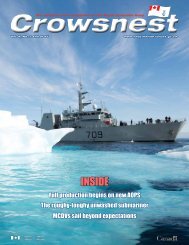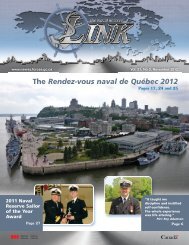You also want an ePaper? Increase the reach of your titles
YUMPU automatically turns print PDFs into web optimized ePapers that Google loves.
1 Introduction 1<br />
<strong>The</strong> maritime environment is immense. It should not be surprising, <strong>the</strong>refore, that seawater is <strong>the</strong><br />
most abundant substance on Earth. Nearly 70 percent <strong>of</strong> our planet is covered with large bodies <strong>of</strong><br />
it which are connected to one ano<strong>the</strong>r to form what can be justly regarded as a single world ocean<br />
(see Figure 1). 2 When looked at in all three dimensions, that global ocean comprises 99 percent<br />
<strong>of</strong> <strong>the</strong> planet’s living space <strong>and</strong> between 50 <strong>and</strong> 80 percent <strong>of</strong> all life on this planet is found under<br />
its surface. 3 Humanity has always been affected by <strong>the</strong> oceans. Interaction between l<strong>and</strong> <strong>and</strong> sea,<br />
along with deep sea ocean currents, help determine <strong>the</strong> world’s climate, <strong>the</strong>reby impacting food<br />
supplies <strong>and</strong> settlement patterns. Global commerce, transportation <strong>and</strong> communications have<br />
developed because <strong>of</strong> <strong>the</strong> unique properties <strong>of</strong> its principal component. Water’s relatively high<br />
density <strong>and</strong> low viscosity means that its surface can be easily travelled. <strong>Maritime</strong> contact <strong>and</strong><br />
commerce between peoples who did not enjoy a close l<strong>and</strong> connection would have been much<br />
more difficult, perhaps prohibitively so, “if seawater were as viscous as molasses.” 4 Until <strong>the</strong><br />
locomotive, <strong>and</strong> later <strong>the</strong> airplane, <strong>the</strong> seas were <strong>the</strong> fastest means <strong>of</strong> transportation. And, last, <strong>the</strong><br />
fact that water in its solid state floats, which is unusual in <strong>the</strong> natural world, 5 creates formidable<br />
maritime hazards <strong>and</strong> is <strong>the</strong> defining characteristic <strong>of</strong> <strong>the</strong> polar seas.<br />
Figure 1: One World Ocean.<br />
Source: Adapted from “Oceano”, Wikipedia [http://es.wikipedia.org/wiki/Oc%C3%A9ano].<br />
1 <strong>The</strong> cut<strong>of</strong>f date for data used in preparation <strong>of</strong> this report is 1 June 2015.<br />
2 Ian Speller, Underst<strong>and</strong>ing <strong>Naval</strong> Warfare (Routledge: London, 2014), p. 17.<br />
3 See United Nations Educational, Scientific <strong>and</strong> Cultural Organisation (UNESCO), World Oceans<br />
Day - Facts <strong>and</strong> Figures [accessed on 25 February 2015 at www.unesco.org/new/en/unesco/events/prizes<strong>and</strong>-celebrations/celebrations/international-days/world-oceans-day-2014/].<br />
4 Roger Revelle, “<strong>The</strong> Ocean”, Scientific American, Vol. 221, No. 3, September 1989, p. 63.<br />
5 I am grateful to my colleague Chad Young for this observation.<br />
DRDC-RDDC-2016-R085 1




